Yes I probbably will use 2nd gear , my tractor is a powershift so i will the high side of 2nd , what do you mean about tying all the twine together?? I look at the spools and I would love to be able to find where it ends and tie a new rool to the end of that but I would think it would get all tangled in itself ...is there a way to do that?
You are using an out of date browser. It may not display this or other websites correctly.
You should upgrade or use an alternative browser.
You should upgrade or use an alternative browser.
OK HERE GOES NOTHING ...NEWBEE HAYER IN THE FIELDS HELP!!!
- Thread starter newbee83
- Start date
- Views: 14824
/ OK HERE GOES NOTHING ...NEWBEE HAYER IN THE FIELDS HELP!!!
#31
these are all good ideas--- hope you didnt jump off the deep end with this "purchase"-- have you ever put up hay before?---this is just a thought -- and dont take it the wrong way-- but if the guy you bought the equipment from is someone you know -- or is a decent enough fella-- maybe ask him to come out to your place to go over the particulars of the equipment---from top to bottom--- anything that needs to be maintained to anything to watch out for that may break--- maybe offer to pay him for his time-- that would be invaluable to you as you could get a tidbit here and one there on this forum (which is good to dont get me wrong)-- but he could give you 200 in 30 minutes that pertain specifically to your equipment---as in someone pointing to the parts is easier than typing in the words from my experience....
trial by fire it seems -- so --buckets of luck to ya' and wear your seat belt.
trial by fire it seems -- so --buckets of luck to ya' and wear your seat belt.
There are quite a few videos on YouTube showing the various stages of cutting, raking and baling. Try to think it this way (for your equipment), it used to be done by horse drawn machinery. Not much has changed since. So keep the ground speed the same as a horse's walk. That means rpm, gears, and hay flow rate all synchronized to this ground speed.
I've gotten 100 bales per acre out of people's "lawns". It depends on whether it was fertilized, watered, and time of the year. Look for and watch a good reliable weather forecast. Your average "feel good" weather forecaster is wrong 50% of the time. You can do better than them by looking at a national weather map. Look for the fronts leaving California. You have 3 days until they arrive. You need 3 days of drying time at 80+ degrees to get good hay. Don't cut all your acreage at one time or you'll burn out yourself or a machine. Try just and acre or so until you get the hang of how it all goes together...
I've gotten 100 bales per acre out of people's "lawns". It depends on whether it was fertilized, watered, and time of the year. Look for and watch a good reliable weather forecast. Your average "feel good" weather forecaster is wrong 50% of the time. You can do better than them by looking at a national weather map. Look for the fronts leaving California. You have 3 days until they arrive. You need 3 days of drying time at 80+ degrees to get good hay. Don't cut all your acreage at one time or you'll burn out yourself or a machine. Try just and acre or so until you get the hang of how it all goes together...
zz I think I am going to take your advice and maybe try to do the smaller field first...its about five acres and see how all the equipment works and how I hold up hahah, My 2nd gear in the 3rd powershift stage is about 5 mph at half throttle , i dont want to wind the **** outta of the equipment I just dotn think there is a need for it its not a race, well maybe against the rain it might be haha
sweettractors
Advertiser
Don't get in a hurry with the square baler, give it time to do its job and you will have less sheared pins and busted bales from non tying, etc. Ken Sweet
flusher
Super Member
- Joined
- Jun 4, 2005
- Messages
- 7,555
- Location
- Sacramento
- Tractor
- Getting old. Sold the ranch. Sold the tractors. Moved back to the city.
This is all used equipment, but it very good shape.I bought the whole set up from a guy down the road about 15 Mins away from me, I am haying a grass,timothy clover mixture as of now next yr I have a few fields that will be full timothy. Does anyone know what a moisture meter runs? Now do you test it when it is still standing or after you bale it? Thanks for all the help
Also I have orderd all the manuals off online they should be in anyday now.
Cheapie moisture meters $50-100. Baler mounted with remote readout-several hundred bucks.
You should check the moisture level in the crop before mowing. You can do that with a hand-held moisture meter or dry out a sample in a microwave (weigh before and after drying) and calculate the % moisture.
flusher
Super Member
- Joined
- Jun 4, 2005
- Messages
- 7,555
- Location
- Sacramento
- Tractor
- Getting old. Sold the ranch. Sold the tractors. Moved back to the city.
Also what are these wedges everyone is talking about?? why would you remove them and reinstall them? Is it depending on the hay your baling?
The wedges are installed on the walls of the baling chamber. Here's what they look like on my Massey Ferguson 124 baler.
Two wedges are in there now.
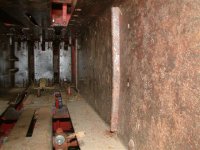
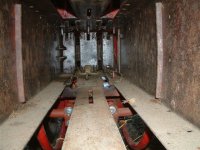
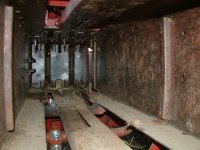
The 124 can accommodate 3 pairs of wedges. The baler only came with one pair so I welded up additional wedges using scrap steel angle and bar stock.
Wedges are handy when baling a dry crop that is not packing sufficiently tight. Usually you install the wedges in pairs.
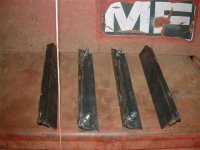
flusher
Super Member
- Joined
- Jun 4, 2005
- Messages
- 7,555
- Location
- Sacramento
- Tractor
- Getting old. Sold the ranch. Sold the tractors. Moved back to the city.
Ok that 1 stroke a second helps a ton to know, Now as far as running the twine it looks like the wrap it like 2-3 time around the needle or finger i guess ??? Does this seem right? It first goes through two porcelin eyelets before this ? Now I am going to try to bale a total of about 30-35 acres this year, does anyone know approx how many bales this will yeild? I want to make sure I have enough storage.Thanks Again
Threading the twine is pretty straightforward, but there are a few wrinkles.
Here's what it looks like with my MF124 two-twine baler.
The two twines come out of the box and go through the twine tensioner (a simple spring-loaded clamp).
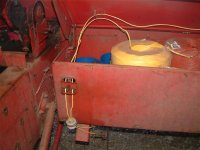
Then the twines go through those guides which are flexible. On the 124 you adjust the twine tensioner until those guides move 1.5 to 2.5 inches before the twine starts moving through the tensioner. It's a fairly crude adjustment, but it gets the job done. I know that the JD 14T baler specifies that the twine tensioner be set for 15 lb of drag on the twine.
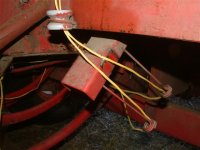
Next the twines go through the eyes of the needles. You tie the ends of the twine onto one of the support brackets on the underside of the baling chamber.
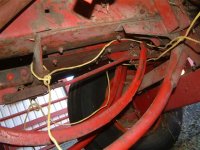
Then you go topside and spin the toothed metering wheel to raise the metering arm until it settles in the slot on the end of the arm (the arm is spring-loaded). This engages the clutch on the knotter drive shaft.
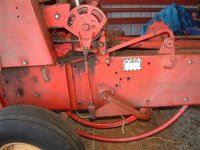
You then rotate the flywheel in the normal direction for baler operation. I do this by hand. The knotters will go through a complete cycle with the needles bringing the twine to the knotters which grab the twine in the twine holder, wrap the twine in the knotters and cuts the twine with the knotter knives (the knives have to be real sharp for this to work, so sharpen them if you haven't already). You end up with the knotters properly loaded with twine and two pieces of scrap twine under the baler. Untie the scrap and discard.
sweettractors
Advertiser
The stop at the top of the metering arm is where you adjust the length of your bales. Moving down, shortens the bale. Ken Sweet
